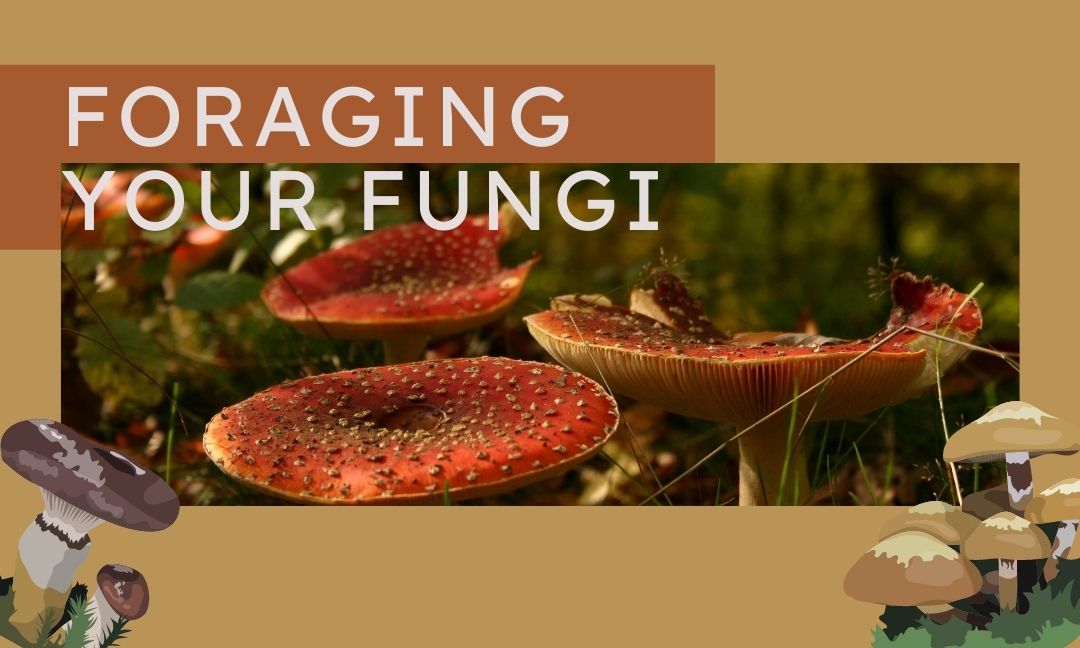Author: S. R. van der Heide
Editor: Connor Fraser
Graphic Designer: Emily Sheng
Publisher: Rayna Almas
Foraging for food has been part of our society since the start of time. Finding plants, fungi, and other edible resources is a powerful skill, not as out of reach as one might think.

By participating in foraging you:
- Get involved in your food
- Explore your local wildlife
- Learn about local vegetation
- Get connected in your community
- Discover more fun hobbies! (Spore prints, cooking, analyzing fungus…)
These are all right at your fingertips, and right outside your door!
Mushroom Etiquette
Foraging, like everything else, has proper etiquette to follow. Nothing stifling, like wearing a tie or keeping your hair up, but rules about making sure you are protecting the environment in which you are interacting.
The main point of etiquette is to leave at least ½ of the mushrooms there. It is vital not to take the whole patch so that mushrooms can finish their life cycle and spread their spores. Try to take the oldest mushrooms of the group- especially if they have already released their spores. Be careful not to step on any of the other mushrooms!
Whenever I gather a mushroom that I do not end up eating, I will return it to where I found it. This way, the mushroom can decompose and release its spores, giving birth to the next round of mushrooms! That practice is not a rule of etiquette but will also help conserve the environment and ensure everyone can enjoy foraging.
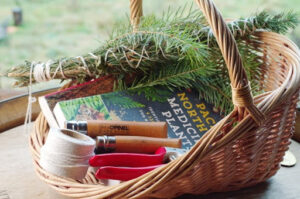
Find Your Tools
Before you start foraging, there are a couple of things to learn and gather. In regards to tools, there is not a lot you have to worry about, and I can almost guarantee you have everything you need at home.
All you need is a bucket or basket and some information. That’s it! Some people will carry scissors or knives to help cut stems, but this is not a requirement and should not be done if you are foraging alone, to ensure your safety in case of an accident. You do not need protective gloves to keep you safe from poisonous mushrooms, as they only affect you if ingested. Foraging is an incredibly accessible activity and does not require that you buy equipment. It does, however, require that you do some precautionary prepping.
Never Munch on a Hunch
“Never munch on a hunch” is a saying in the foraging community. You should never ingest any food you find without first finding out what it is. This is especially important when you are dealing with mushrooms. Mushrooms often have closely related families that have wildly different effects on people.
Discerning your mushroom is where the first two hobbies that come with foraging begin with analyzing fungi and spore printing. When you have finished gathering your mushrooms and have brought them home to use, you will first need to identify what mushrooms you have collected.
Start by examining the mushroom’s characteristics. Are its gills connected? Does it have pores? How big is it? Does it smell?
Next, you will want to take a spore print of your mushroom. To take a spore print, you will place the mushroom on a piece of paper (white or black, depending on the mushroom- you can base this off your preliminary examinations). The cap should be against the sheet with the gills facing down. Place a small drop of water on top of the cap to encourage spore release. In an hour or so, you will have a print of the spores on the paper beneath it. This process might take much less or much more time, depending on the mushroom and how old it is.
In using the distinct characteristics of the mushrooms, and the spore print, you should be able to find a match for your mushroom!
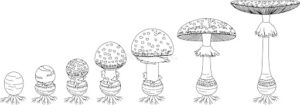
Get to Know Your Mushrooms
When you get involved in a new hobby, it is good to get acquainted with your materials. To fully appreciate fungi life, you have to learn how it works!
Mushroom anatomy is similar to plant life. However, the fungi functions more similarly to human life. Mushrooms breathe oxygen and expel carbon, take their nutrients from other organisms, and use bacteria to improve their immune systems.
The life cycle of a mushroom is very consistent and circular. They use a system of mycelium and hyphae (similar to roots) to absorb nutrients and grow big and strong. The mushroom continues to grow until it reaches its fruiting stage. The fully developed cap of the mushroom is the fruit, while the stem, mycelium, and hyphae are what is known as the fungus. At the fruiting stage, the mushroom is fully grown and is reaching the end of its life cycle. As the mushroom moves past its peak, it starts releasing its spores. The spores embed into the ground and will grow into the next generation of mushrooms.
Mushrooms Near You
Ontario is full of a diverse range of mushrooms. For beginner foragers, there are easily recognizable mushrooms right outside your door! Mushrooms such as Fairy Rings, Stump Puffballs, Rosy Gomphidius, and Crab Brittlegill, are right outside your door.
Here is how you can recognize them!
Fairy Ring
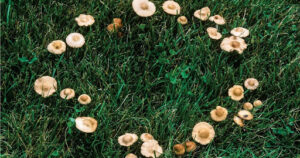
Fairy Rings are prevalent in mythology about fairies, making them easily spottable! The mushrooms are light brown, with decently-spaced gills. They have a bump in the middle of their cap and grow in grassy plains such as Victoria Park. Their stems are very tough to break, and their spore deposits are white. Fairy Rings would take a spore print using black or another dark paper.
Stump Puffball
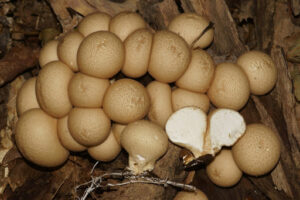
The stump puffballs grow together in clumps around wood. They are attached to the wood using very thin white hyphae. Their spore prints are greenish-brown, and the mushrooms themselves are entirely round! They are part of the puffball family of fungi that grow to be spheres.
Rosy Gomphidius

These beautiful mushrooms have a light pink cap that is sticky to touch. The base of their stems is yellow, and the tops of the stems are partially covered by their elongated gills. The Rosy Gomphidius has a black spore print and should be taken on paper that is white or another light colour.
Crab Brittlegill
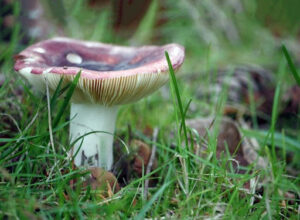
The Crab Brittlegill stands out quite a bit from these other mushrooms I have discussed for a very distinct reason. When mature, the crab brittlegill has a very strong odour of crab. Any look-alike mushroom will lack this smell, meaning if you think it might be crab brittlegill but it does not smell like a crustacean, it must be a different fungus.
This well-named mushroom has a very brittle stem and gill that breaks easily. When cut, the flesh begins to change into a rusted colour, and the spore print is a nice yellow!
Have Fun!
Now that you are prepared to forage, you can get out there and find mushrooms! Remember to be responsible and to respect the wildlife and ecosystems you encounter. Enjoy taking a step into nature and your diet.
Sources:
https://northernbushcraft.com/mushrooms/ontario.php
https://networkofwellbeing.org/2018/08/09/foraging-as-a-route-to-wellbeing/
https://northernbushcraft.com/mushrooms/fairyRingMushroom/on.htm
https://northernbushcraft.com/mushrooms/_stump_puffball/on.htm
https://northernbushcraft.com/mushrooms/rosyGomphidius/on.htm
https://northernbushcraft.com/mushrooms/_crab_brittlegill/on.htm

